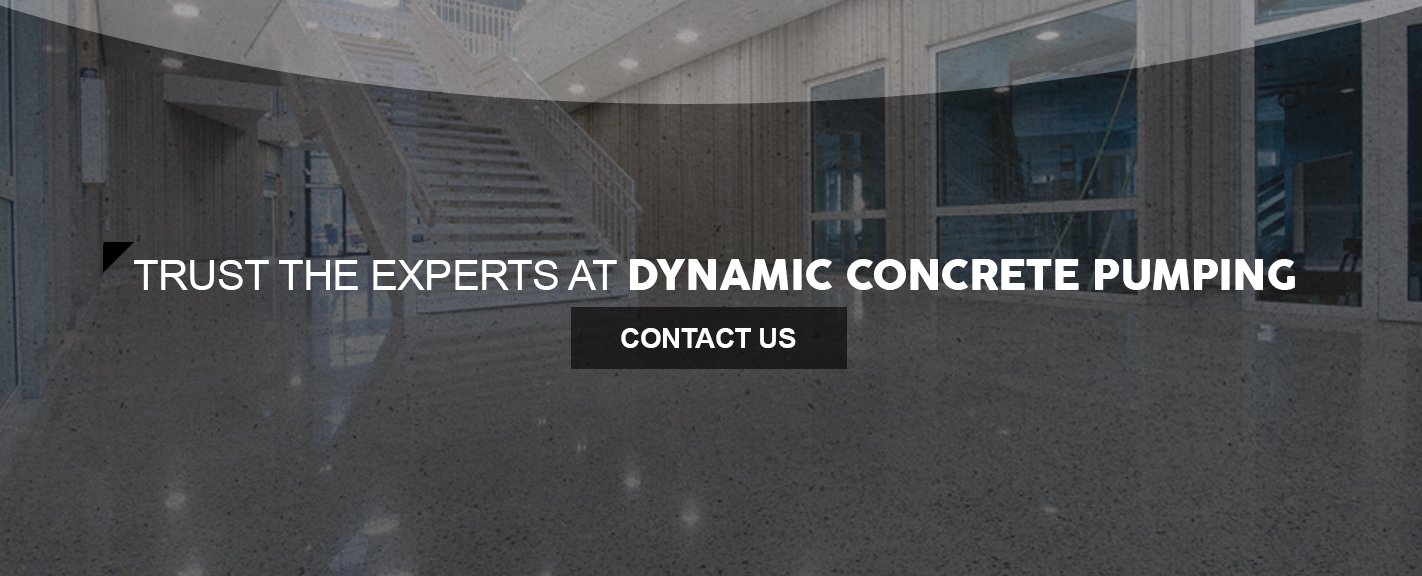
Benefits of Polished Concrete Floors
Posted By:Dynamic Concrete Pumping , Date: Feb 22, 2019
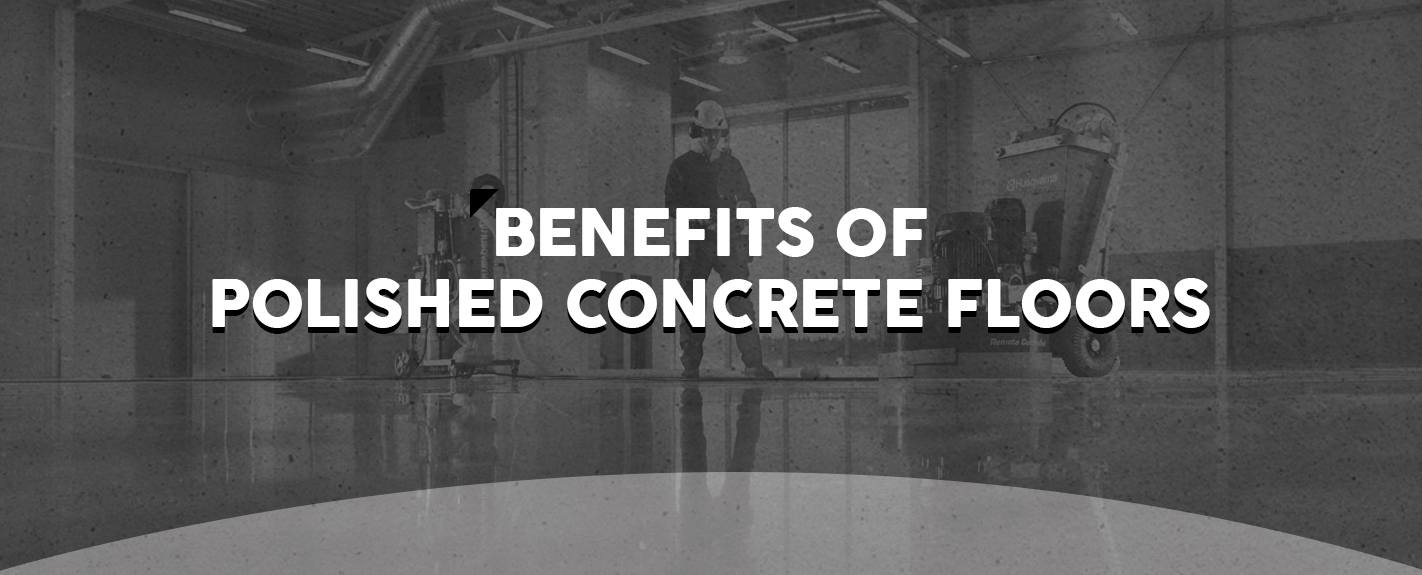
What if you wanted a commercial or industrial floor that had it all? One that could stand up to wear without the need for serious maintenance, one that could look beautiful and last a lifetime, all while being extremely affordable? It may sound too good to be true, but polished concrete floors are all these things and more.
Let’s take some time to look at how the concrete polishing process works, what benefits these floors offer, some common applications and how to keep them clean and shiny over time.
Concrete Polishing Process
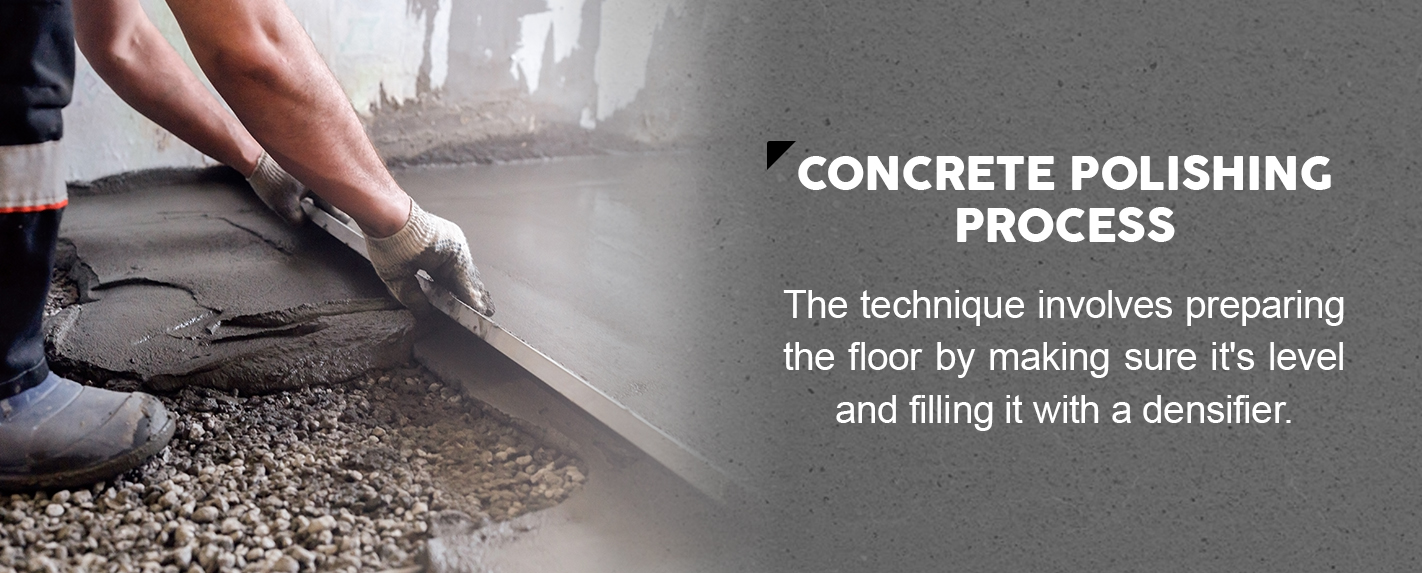
The concrete polishing process depends in part on the finish you want. Mostly, the technique involves preparing the floor by making sure it’s level and filling it with a densifier. Then, the floor’s surface gets ground down to achieve the desired finish, whether you prefer a more matte finish or a high-gloss, mirror-like finish. Finishes that more fully expose the aggregate require a more involved grinding process. However, that type of finish is uncommon in commercial spaces.
Let’s break this down further with a step-by-step guide on how to polish concrete floors.
- First cut: The first cut prepares the floor for the rest of the process. If there are any coatings or uneven spots to remove, the concrete finisher professional will use a metal-bond diamond tool with a coarse grit, such as 20/30, to grind the floor down. Otherwise, a 50/60 or a 100/120 grit metal diamond works for the first cut. This step opens up the floor so it’s porous enough to absorb the densifier.
- Grout: If the initial grinding process creates any air pockets, hairline cracks or tiny holes, the concrete finisher should fill them in with an acrylic-based grout. While the grout is still wet, the concrete finisher will use a 100/120 grit metal diamond to go over the grout, filling in the pores. Finally, the floor gets cleaned with a squeegee.
- Densifier: The next step is to apply the densifier, which hardens the cement and grout and prepares them for polishing. After the densifier has fully dried, higher-grit hybrid diamonds can remove any scratches the metal-bond diamonds may have left behind. The floor should appear smooth for the next step.
- Polish: Now the floor is ready for the main polishing. The final aesthetic and texture you want to achieve will influence what levels of grit the concrete finisher will use to polish the floor. Often, the process begins with 400-grit resin abrasives, which may be the only abrasives needed if you’re going for a lower-gloss finish. For a higher-gloss finish, the concrete finisher may then use an 800-grit resin pad.
- Guard/sealer: To finish and protect the floor, the concrete finisher will apply a guard that will soak into the floor. Once it cures, the guard gets buffed, leaving the floor more durable. A topical sealer can also work instead of a guard, but it will sit on the surface rather than penetrating the concrete, meaning you may eventually need to reapply another coat. A sealer may also need curing with a high-speed burnisher.
Benefits of Polished Concrete Floors
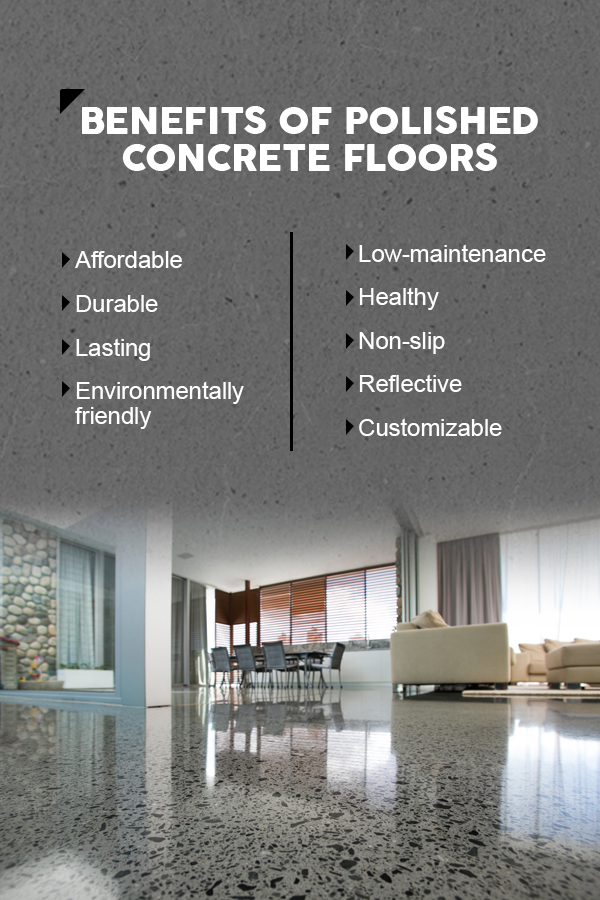
So, why are polished concrete floors desirable in so many commercial spaces, warehouses and even homes? People have discovered polished concrete floors offer a whole host of benefits. In looking at the pros and cons of concrete polished floors, it’s easy to see polished concrete has far more advantages than disadvantages.
The only notable downside to concrete has to do with the way it may feel walking on it. For one, concrete is hard and doesn’t give underfoot, so it may not be comfortable to stand on for long periods. Of course, this hardness can be an advantage when it comes to durability and strength. You can also compensate for any discomfort by adding mats to areas where employees may stand for long stretches.
Concrete can also feel cold at times. This concern occurs more often in a residential space where people may be barefoot, but isn’t much of an issue with commercial or industrial concrete flooring. The good news is that polished concrete floors are excellent thermal conductors, so a radiant floor heating system can keep the floor warm for bare feet.
Now, let’s look some valuable advantages polished concrete floors offer, including the following.
- Affordable: Despite polished concrete’s high-end appearance, the reality is that it’s more affordable than most other flooring options. Not only is the initial cost per square foot similar to other inexpensive options like carpet, but the whole lifecycle cost is lower than any other popular types of flooring. It is particularly affordable if you already have a concrete slab you can get professionally polished.
- Durable: Polished concrete’s durability is second to none for manufacturing and warehousing facilities. Polished concrete flooring is solid, and can stand up to heavy foot traffic or even heavy equipment in a warehouse. It’s almost impossible to chip, scratch or otherwise damage polished concrete floors. Sealed polished concrete floors are also resistant to chemicals like alkalis and acids that could cause corrosion.
- Lasting: Polished concrete floors are sturdy. In many cases, a properly installed and well-maintained polished concrete floor can still last over a century, even if it stands up to a lot of wear and tear! Flooring materials like vinyl, wood laminates and carpeting can’t compete with this lifespan.
- Low-maintenance: Polished concrete floors are easy to maintain. They don’t require you to periodically strip the surface and apply wax or other coatings like many other flooring types do. They’re even easy to clean. They don’t hold onto dirt or dust like other floors do and only require occasional mopping.
- Environmentally friendly: Because polished concrete floors don’t involve the use of hazardous chemical coatings, cleaners or adhesives in their installation or upkeep, they are an eco-friendly option. These floors are also energy-efficient, which further add to their reputation as a “green” flooring choice.
- Healthy: Polished concrete is sealed and, therefore, stays dry. Because it’s smooth and nonporous, it doesn’t allow allergens, dirt and bacteria to collect in any crevices. Unlike hardwood and carpeting, polished concrete also does not contain any harmful volatile organic compounds. All these factors make for improved air quality.
- Non-slip: Some people may be worried about the slipperiness of polished concrete since it’s so smooth. If safety is a concern, a non-slip epoxy coating can add the right amount of texture to the surface of the concrete to prevent people from slipping on the surface. With the proper coating, a polished concrete floor can be perfectly safe.
- Reflective: Polished concrete floors with a high-gloss finish are incredibly reflective. Not only do they look sleek and luxurious, but they can also help introduce more light into your space. These floors can cut down on the amount of artificial light you need to use, resulting in a lower electric bill. More light can significantly enhance the ambiance in a space.
- Customizable: You may have a specific mental picture of what polished concrete floors look like, but the options are endless when it comes to the final look of a polished concrete floor. Not only can you select various levels of shine, but you can also choose from multiple aggregates, colors and patterns. You can even personalize the floor with a decorative engraving or graphic.
With so many benefits, it should be easy to see why polished concrete floors are becoming increasingly popular. Whether you want warehouse polished concrete for its ability to hold up to heavy equipment or a commercial polished concrete floor for its unique combination of affordability and aesthetics, this versatile flooring option won’t disappoint.
Common Applications of Polished Concrete Floors
Concrete floors are versatile enough to work well in a variety of settings. Here are a few examples of buildings where polished concrete floors are the perfect flooring option.
- Retail stores: Retail stores need floors that can handle heavy foot traffic. Since stores have clothing racks, shelves and other structures all over the floor, needing to move everything for waxing or other maintenance tasks is a massive undertaking. It would require a great deal of labor and a long store closure that isn’t always feasible. Thankfully, polished concrete floors can handle heavy foot traffic and don’t require waxing.
- Salons: Hair and nail salons typically want to project a sleek and stylish image. High-gloss polished concrete floors can add significantly to this aesthetic. They also make it easy for hair stylists to sweep up hair. If dyes spill on the floor, they aren’t likely to stain. In short, these floors are both functional and stylish.
- Restaurants: Many restaurants still have carpet on their floors, but carpeting can be unsanitary and hard to clean. Tiled floors may involve less effort to keep clean, but they often trap dirt and bacteria in the grout between tiles. Polished concrete floors in a restaurant make for easy cleanup and won’t hold onto anything unsanitary.
- Warehouses: Warehouses need floors that are durable, first and foremost. Not all flooring can hold up to heavy industrial equipment driving on it, but concrete can. What’s more, tires on forklifts or other equipment aren’t likely to leave track marks on industrial polished concrete flooring. Dust can be prevalent in a warehouse, but you don’t have to worry about polished concrete trapping any.
- Offices: Office buildings can sometimes feel dark or over-reliant on fluorescent lighting. A recent study found American employees consider natural light to be the No. 1 perk an office can offer, yet this benefit is something more than one-third of employees don’t get enough of in their current office environment. Polished concrete floors can improve lighting, in addition to offering many other benefits for office buildings.
- Hospitals: Hospital floors need to be smooth to help make wheelchairs or beds on wheels easy to push across the floor. They also need to be easy to clean and as sanitary as possible. They should furthermore be resistant to chemicals in case of a spill. Polished concrete floors meet all these needs and will give your hospital a lovely, modern look.
- Hotels: All too often, hotel floors feature outdated carpet that takes away from a space that may otherwise appear modern and luxurious. Of course, high-end materials like marble or other types of natural stone are costly. Polished concrete can offer a similarly opulent look and durability at a tiny fraction of the cost.
- Auto showrooms: The sleek appearance of polished concrete also makes it an excellent choice for auto showrooms. Whether sitting still or rotating on a platform, cars are sure to look their best surrounded by a mirror-like floor that reflects light upon them. These floors can also handle the weight of moving cars.
- Homes: While you might expect to see polished concrete floors in commercial or industrial spaces, they are becoming increasingly common in some residential spaces, as well. Homeowners who want to achieve a modern, industrial feel or who want to imitate the look of other high-end flooring materials won’t find a better option than polished concrete.
Polished Concrete Floor Maintenance
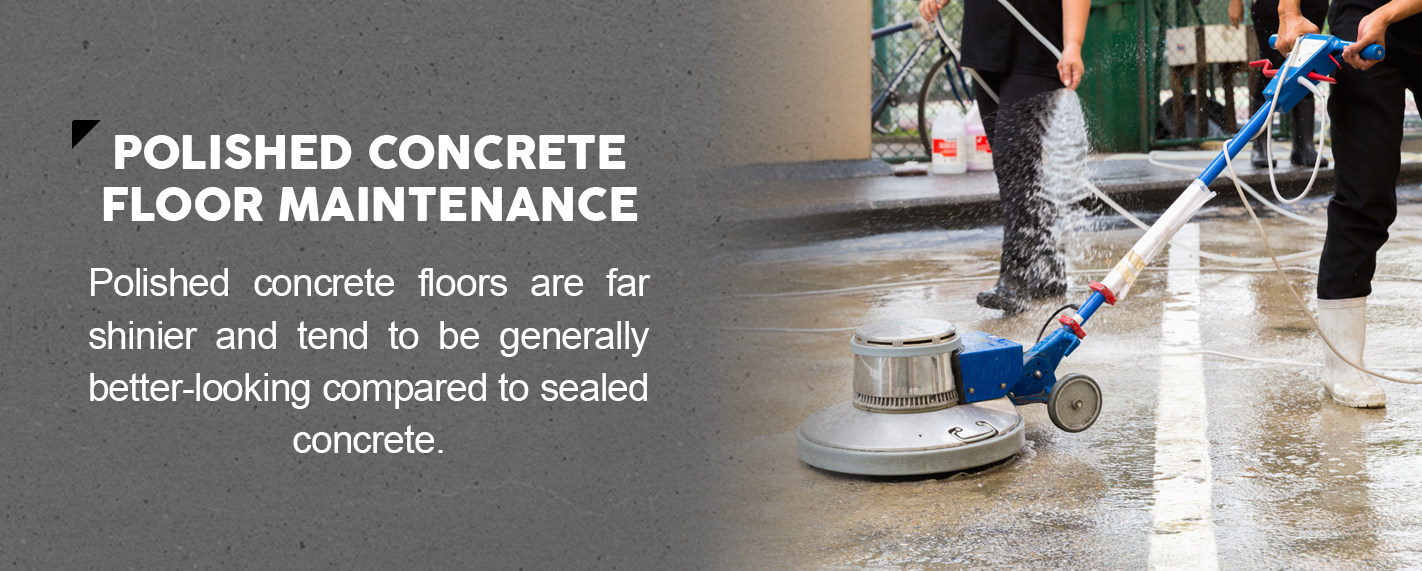
You may be wondering what sets polished concrete apart from sealed concrete. The main differences between polished concrete vs. sealed concrete are appearance and maintenance. Polished concrete floors are far shinier and tend to be generally better-looking compared to sealed concrete. But what if you don’t care about appearance? The other big difference is that sealed concrete isn’t as durable and requires periodic resealing. Foot traffic or any other impact can wear off the seal on top, leaving you with bare concrete.
So, we know polished concrete doesn’t require ongoing sealing or waxing, but that doesn’t mean it doesn’t require any maintenance at all. Proper cleaning and caretaking ensure your floors will keep their beautiful shine. So, what does this ongoing maintenance entail? The key is easy, ongoing care for the floor. Basic dusting and mopping your floor can keep it free of any abrasive materials and help it look its best.
Typically, you want to use a dust mop on your floors daily. Push a dust mop with a microfiber pad across the floor to collect any dust or dirt sitting on the surface. These particles can be abrasive to the floor.
As for mopping, that can usually be less frequent. Be sure to clean up spills and stains quickly. Whenever you need to wet mop the floor, use a neutral-pH floor cleaner and give it time to work, but don’t let it dry before using either a traditional mop or an automatic scrubber equipped with a nonabrasive pad to clean the surface.
Trust the Experts at Dynamic Concrete Pumping
If you’re interested in having brand-new polished concrete floors installed or turning your current dull concrete floors into a thing of beauty, call on the experts at Dynamic Concrete Pumping. With over 40 years of experience, we know exactly how to help you achieve the exact functionality and look you desire. If you’re looking for polished concrete flooring in Alberta, Saskatchewan, British Columbia and the surrounding region, you can count on our hard-earned reputation for excellence.
In addition to our expertise, we have the benefit of top-of-the-line tools, sealants, stain guards and more so we can ensure your floor doesn’t just look great now, but will hold up and maintain its beauty for many years to come. With so many advantages, why not consider polished concrete floors for your next project? To get started, submit an online information request form today.
-Updated 11/21/2019


